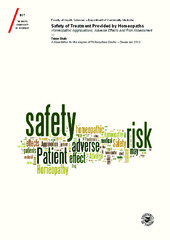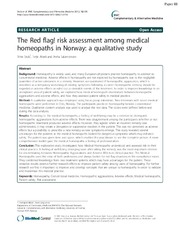| dc.contributor.advisor | Alræk, Terje | |
| dc.contributor.author | Stub, Trine | |
| dc.date.accessioned | 2014-09-03T10:49:30Z | |
| dc.date.available | 2014-09-03T10:49:30Z | |
| dc.date.issued | 2014-03-28 | |
| dc.description.abstract | Introduction
Homeopathic treatment has a long tradition. Because of its widespread use as alternative therapy in Norway and Europe, but also in nations such as India, investigation into patient safety related to homeopathic treatment is important. Risk in homeopathy can be divided into direct and indirect risk. Direct risk is directly linked to the intervention itself while indirect risk is related to the setting effects, such as e.g. the practitioner, rather than to the homeopathic remedy. Homeopathic aggravation, a concept specific for homeopathy, may impose a particular risk as it allows the health status of the patient to deteriorate before there is an improvement. In homeopathic theory, such a temporary deterioration is seen as being a part of the healing process.
Aims
In this research plan, adverse effect was understood as all diseases or unwanted and/or harmful reactions appearing during a study period, regardless of their relation to the actual treatment. The term encompasses all unwanted effects, without making assumptions about their mechanisms. It thus avoids ambiguity and the risk of misclassification.
The aim was to explore and provide more knowledge about patient safety in homeopathy. With regard to safety, particular emphasis was placed on the concept of homeopathic aggravation.
Materials and Methods
A mixed method approach combining qualitative and quantitative methods was used, including four focus group interviews, a cross-sectional survey, a systematic review, and a meta-analysis.
Results
Initial steps were taken towards development of guidelines for the assessment of risk in homeopathy. The results suggest that both lay as well as medical homeopaths assessed the patient risk precisely according to the guidelines developed in this research project. Adverse effects as well as homeopathic aggravations were reported by patients after homeopathic treatment. According to the CTCAE criteria, these events were mild to moderate and transient. According to the systematic review and meta-analysis included in this research plan, direct risk related to the homeopathic remedy was found to be minor and moderate, apart from five cases of homeopathic aggravations that were graded as serious. The meta-analysis suggested that adverse effects were reported to a similar degree in the homeopathy compared to the placebo groups.
Conclusion
According to the systematic review and cross-sectional study included in this research plan, homeopathic treatment is generally associated with low to moderate direct risk related to the remedy. Indirect risk, however, is associated with homeopathic practice where the concept of homeopathic aggravations imposes a particular risk. To control for indirect risk and improve patient safety, it is important to distinguish between homeopathic aggravations and adverse effects within homeopathic theory. Criteria to distinguish these two concepts must, however, be acceptable to homeopaths and applicable in everyday practice. Furthermore, it allows comparison of safety data across studies on homeopathy. A reporting system for adverse effects in homeopathy should include criteria to distinguish these two concepts, among others, which enables homeopaths to apply this reporting system. Moreover, severity and duration of both homeopathic aggravations and adverse effects need to be classified within the same grading system. The criteria developed in the research plan presented here were tested and found relevant for safety purposes. In addition, it turned out that high medical and homeopathic skills are required to assess patient risk accordingly, which is heavily dependent on homeopathic training and education. Consequently, there is considerable potential for risk related to homeopathic practice due to the current, legal regulation of the profession. | en |
| dc.description.doctoraltype | ph.d. | en |
| dc.description.popularabstract | 1. Overskrift:
Pasientsikkerhet ved behandling hos homeopat
Ingress:
Det er knyttet liten direkte risiko til homeopatiske midler. Det kan imidlertid knyttes indirekte risiko til homeopatisk praksis, dersom behandler mangler medisinsk innsikt.
Homeopati har vært en av de mest brukte alternative behandlingene i Europa over lengre tid. Det finnes likevel lite forskning på risiko og bivirkninger av behandlingen. Pasientsikkerhet blir derfor utgangspunktet for denne avhandlingen.
Avhandlingen vil både undersøke hyppighet og alvorlighetsgrad av reaksjoner som pasienter har rapportert etter behandling hos homeopat.
Dernest hvordan homøopater selv vurderer risiko, og hvilke faktorer de anser som truende for pasientsikkerheten.
Resultatene fra denne studien viser at det er liten direkte risiko forbundet med de homeopatiske midlene.
Med homeopatisk praksis følger imidlertid indirekte risiko.Dette knyttes spesielt til homeopatiens forventninger om at behandlingen kan føre til en umiddelbar forverring i sykdomssymptomene. Homeopatene anser dette som en naturlig del av tilfriskningsprosessen. Dette kaller de førstegangsforverring, til forskjell fra bivirkninger, som de anser som en uønsket utvikling i sykdom og symptomer.For å kunne sammenligne data om homeopatiske forverringer og bivirkninger har jeg undersøkt hvilke kriterier erfarne homeopater bruker for å skille mellom disse. Avhandlingen undersøker også hvorvidt forventningen om forverringer kan gjøre at pasienter unngår å oppsøke nødvendig konvensjonell behandling, eventuelt utsetter denne.
Avhandlingen diskuterer videre hvordan man kan bruke homeopatenes erfaringer med risiko i behandling, for å bidra til bedre pasientsikkerhet.Som et ledd i dette arbeidet vil jeg også sette homeopatiske risiko-forståelser inn i rammen av konvensjonell medisin. | en |
| dc.description.sponsorship | Norske Hoemopaters Landsforbund (NHL) har bidrat med økonomisk støtte til denne forskningen | en |
| dc.description | Papers 1, 2 and 4 of this thesis are not available in Munin: <br/>1. Stub T, Raak C, Ostermann T, Musial F, Alraek T: 'Adverse effects of homeopathy, what do we know? A systematic review and meta-analysis of Randomized Controlled Trials' (manuscript) <br/>2. Stub T, Salamonsen A, and Alraek T.: 'Is it Possible to Distinguish Homeopathic Aggravations from Adverse Effects? A Qualitative Study', Forschende Komplementärmedizin/Research in Complementary Medicine (2012), vol. 19(1):13-19. Available at <a href=http://dx.doi.org/10.1159/000335827>http://dx.doi.org/10.1159/000335827</a> <br/>4. Stub T, Kristoffersen A, Alraek T, Musial F, Steinsbekk A.: 'Risk in Homeopathy: Classification
of Adverse Effect and Homeopathic Aggravation – A Cross Sectional study among Norwegian Homeopathy Patients' (manuscript) | en |
| dc.identifier.uri | https://hdl.handle.net/10037/6614 | |
| dc.identifier.urn | URN:NBN:no-uit_munin_6209 | |
| dc.language.iso | eng | en |
| dc.rights.accessRights | openAccess | |
| dc.rights.holder | Copyright 2014 The Author(s) | |
| dc.rights.uri | https://creativecommons.org/licenses/by-nc-sa/3.0 | en_US |
| dc.rights | Attribution-NonCommercial-ShareAlike 3.0 Unported (CC BY-NC-SA 3.0) | en_US |
| dc.subject | VDP::Medisinske Fag: 700::Helsefag: 800 | en |
| dc.subject | VDP::Medical disciplines: 700::Health sciences: 800 | en |
| dc.title | Safety of Treatment Provided by Homeopaths
Homeopathic Aggravations, Adverse Effects and Risk Assessment | en |
| dc.type | Doctoral thesis | en |
| dc.type | Doktorgradsavhandling | en |


 English
English norsk
norsk

